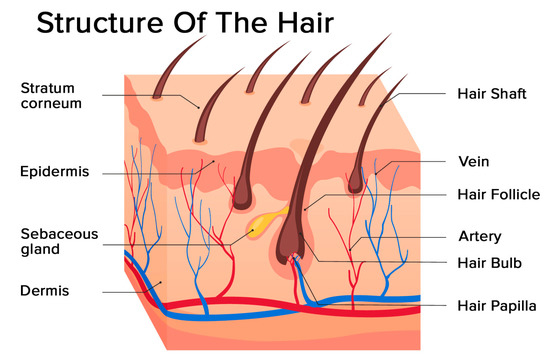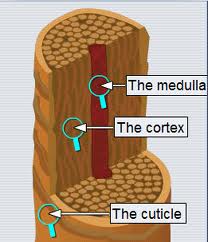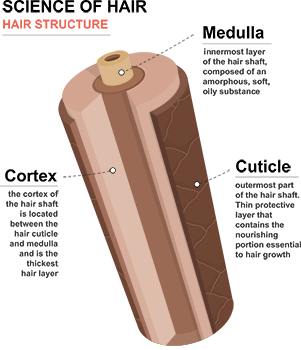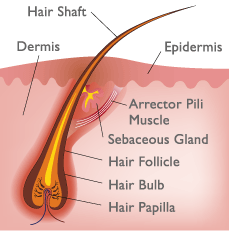What Are the Three Parts of the Hair Shaft
Each hair shaft is made up of two or three layers. Your hair is made of two parts - the hair follicle and the hair shaft.

Ijms Free Full Text Hormonal Effects On Hair Follicles Html
This trait is determined by the hair follicle volume and the condition of the strand.

. The hair shaft is the solitary part of the hair follicle that fully exits the surface of the skin. In the hair bulb living cells divide and grow to build the hair shaft. The main structure of hair consists of the root hair follicle and the hair shaft.
Hair shafts are the visible part of hair on the surface of the skin. The cortex the middle layer of the hair shaft which provides the strength colour and texture of a hair fibre. The hair shaft is formed of three layers.
As a piece of hair grows it goes through three phases before it sheds and a new one grows. Hair Shaft Structure In the basic hair structure diagram above you can see that the hair shaft has three layers. The dermal papilla is responsible for regulating the hair cycle and hair growth and is also comprised.
A hair follicle anchors each hair into the skin. Made of flattened cells that overlap like the tiles on a terra-cotta roof the cuticle protects the inside of the hair shaft from damage. What are the three parts of the hair.
It has the following parts. The consistency of hair can almost always be grouped into three categories. The matrix surrounds the dermal papillae and contains all the active cells needed for hair.
Blood vessels nourish. The papilla provides blood supply to the hair follicles for healthy hair. The cortex the middle layer of the hair shaft which provides the strength colour and texture of a hair fibre.
The cuticle is the outermost layer. These cells work defensively to prevent damage to the hairs inner structure and to control water content of hair fiber. The cuticle the outer layer of the hair shaft is thin and.
Hair Anatomy Parts of the Hair. The bulb is found at the root of your hair where the protein cells keratin grow to make hair. The cuticle outer layer cortex middle layer and medulla inner layer.
Hair follicle anchors or holds the hair into the scalp. It serves as protection to the cortex. Within the hair shaft there are three layers.
The cuticle the cortex and sometimes the medulla. Medulla cuticle cortex list three properties of the hairs cuticle. The cuticle is the hairs outer most layer which has shingle or scale like cells that overlap.
Transparent scales protect shaft list two facts about the hairs cortex largest part determines pigment list two facts about the medulla center of hair shaft difficult to see what are the different medulla patterns. Hair shafts protect the skin in a variety of ways. The medulla cortex and the cuticle.
The cuticle the cortex and sometimes the medulla. The medulla is a honeycomb keratin structure with air spaces inside. Made of flattened cells that overlap like the tiles on a terra-cotta roof the cuticle protects the inside of the hair shaft from damage.
The three parts of the hair shaft are the cuticle cortex and medulla. Fine hair has the smallest circumference coarse hair has the largest circumference and medium hair is anywhere between the other two. The cuticle is the hairs outer protective layer and is connected to the internal root sheath.
Correspondingly what is the anatomy of a hair shaft. Each hair shaft is made up of two or three layers. The cuticle is the outermost layer.
Hair shafts have various functions including regulating body temperature protecting sensitive parts of the body from harm and facilitating the evaporation of sweat according to Dartmouth University. There are three main parts to the hair shaft - the medulla the cortex and the cuticle. Fine medium and coarse.
The outermost layer of the hair shaft is called the cuticle a layer of scales covering the outside of the hair shaft. The cuticle the cortex and sometimes the medulla. Toenail Clippers for Arthritic Hands I will break down the basic structure of hair and explain each part in this article.
The cuticle cortex and medulla. The medulla Is the innermost part of the hair shaft made up of rows of polyhedral cells. The hair bulb forms the base of the hair follicle.
Made of flattened cells that overlap like the tiles on a terra-cotta roof the cuticle protects the inside of the hair shaft from damage. Each hair shaft is made up of two or three layers. These layers are the medulla the cortex and the cuticle.
The hair shaft is made up of three layers. Your hair consists of a hair follicle and hair shaft. The hair follicles in your skin contain living cells to allow your hair to grow.
What are the three parts of the hair shaft. The cuticle is the outermost layer. The hair shaft is comprised of three layers.
The medulla the deepest layer of the hair shaft only seen in large and thick hairs. The medulla the deepest layer of the hair shaft only seen in large and thick hairs. The shaftthe part of the hair we seeis made up of dead cells and consists of three different layers.

Hair Structure Botanical Green Care
The Hair Follicle Split Ender Uk

Exploratorium Magazine Hair Page 2

The Anatomy Of The Hair Follicle Hairmax Uk

Drawing Shows How Hair Follicle Was Divided Into Three Parts Download Scientific Diagram

Hair Science And Biology My Hair Doctor Prescription Haircare

Layer Of Hair Structure The Hair Shaft Consists Of Cortexcuticle And Medulla Hair Care And Beauty Concept Stock Illustration Download Image Now Istock
Learn The Science Of Curly Hair Paramount Beauty

Parts Of The Hair You Need To Know About Paawanee
Hairs Structure Anatomy Functions

Structure And Composition Of The Hair

Skin 2 Accessory Structures Of The Skin And Their Functions Nursing Times

Human Hair Anatomy Hair Follicle Anatomy Ny Hair Loss





Comments
Post a Comment